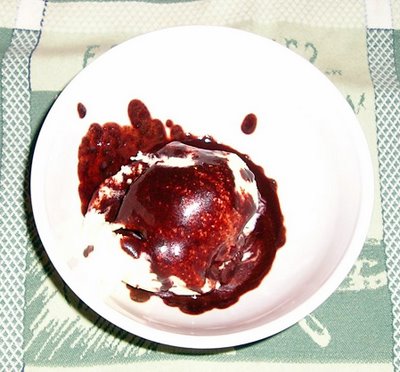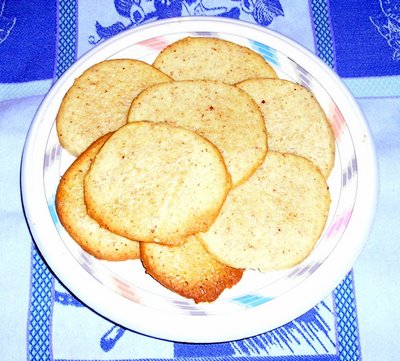Chocolate Sauce

This excellent sauce came about as a result of a discussion that I was having Tuesday with some of my favorite online folk. I won't go into all of the details (because I did that already and somehow deleted the paragraphs), but it was mentioned that a terrific drink base can be made by combining simple syrup, raspberries, lime juice, and chile pepper. This suggestion made me think that what I really wanted was a chocolate syrup made with raspberries and chile pepper (but without lime juice), so I determined to make one.
What I got was really more of a sauce than a syrup, by which I mean that it's a little bit too thick for me to follow through with my original plan of buying a bottle of Hershey's Chocolate Syrup, removing the contents, and replacing them with my chocolate syrup. I could probably fix that by using a more dilute syrup as a starting point, but what I got was so good that I don't think I can be bothered. I'm perfectly content to either warm it slightly in the microwave or just spoon it over ice cream in its semi-liquid state. Or I may just eat it straight up with a spoon. Though it would be a small spoon. It's very good, but it's very rich.
This sauce has a broad spectrum of flavors. When you eat it, you will first notice the very bright clean flavor of the raspberries, followed immediately by the deep, complex flavor of the dark chocolate. At the end, the warm, almost smoky flavor of the chile pepper will assert itself. I couldn't actually taste the cinnamon, so I don't know whether it makes a difference. I should perhaps have left the cinnamon stick in for longer, but I was already fishing out the pasilla chile because I was concerned that its flavor would become too pronounced, so I went ahead and took out the cinnamon, too. I have mixed feelings about cinnamon in chocolate, but since this is something of a Mexican-influenced sauce, the cinnamon seemed like a good idea. It's also supposed to be good for you. As, perhaps, is the dark chocolate. I don't think that anyone thinks the sugar is very good for you, but you aren't going to be eating very much of this sauce at one time, so perhaps you can overlook that.
This recipe makes just over a pint, so if you have a little on some ice cream, you'll still have a pint left.
Chocolate Sauce
1/2 cup water
3/4 cup granulated sugar
1 dried pasilla chile
1 cinnamon stick
1 12-ounce package frozen raspberries
6.5 ounces extra bittersweet chocolate
Put the water and sugar in a saucepan. Break the chile into two or three pieces and add it, along with the cinnamon stick. Put a lid on the saucepan and set over medium heat until the water boils and the sugar is dissolved. Turn off the heat and let sit for five minutes. Remove the cinnamon stick and the chile (and any seeds that got loose from the chile). Add the raspberries, cover the pot, and place over medium-low heat until the mixture reaches a bare simmer. Turn off the heat and let sit for another five minutes.
Mash the raspberries with a potato masher. Pour the mixture through a strainer into a clean saucepan or a four-cup glass measuring cup. Stir the mixture in the strainer to release as much juice as possible from the seeds. You should have about 1.5 cups of syrup.
If you are using a saucepan, bring the syrup to a simmer and turn off the heat. If you are using the measuring cup, microwave the syrup for thirty or forty-five seconds until it is steaming.
Whisk or stir the chocolate into the syrup until it is (relatively) smooth (see below). Let cool, then serve or refrigerate.
I used Trader Joe's 72% chocolate. The 6.5 ounces is approximate. I used three rows of chocolate. There are eight rows in the bar, and the bar is 500 grams, so if I had been able to cut off three rows with surgical precision, I would have had 187.5 grams. I don't think that the recipe is so fussy that half an ounce either way is going to make a huge difference. I do think, though, that, given the sugar you're using in the syrup, you want a fairly strong chocolate. The TJ's 72% chocolate is very good, and there's certainly nothing else like it at its price point. But if all you can find is semisweet chocolate chips, just use a little more chocolate and put a little less sugar in the syrup.
If you happen to think, when you get home from the store or the day before you make the syrup, to put the frozen raspberries in a container in the refrigerator, they will reach the simmer and release their juice faster. If you start with them fully frozen, it will just take a little longer. Take care not to boil the syrup after you've added the raspberries. The very bright flavor of this sauce will be muted if the raspberries are much cooked, and you really don't want to do that.
I used a pasilla chile because it is relatively mild but still has some heat and because it's fairly widely available. I think that it turned out to be a good choice, but if you like other chiles better, then go ahead and try those.
The syrup/sauce never got absolutely smooth, perhaps because of the amount of chocolate or perhaps because it needed some other fat (say a bit of cream) to help it emulsify. It was as if it had very small bits of unmelted chocolate in it, especially as it cooled. It does get a bit grainy after a day in the refrigerator, so it should probably be reheated before serving and served warm.
I may play around with this some more in the future in an attempt to make it either more or less liquid, though I really don't want to change the balance of flavor that I got on this first try. If it were more liquid, I could put it in a squeeze bottle, and that would be kind of cool. If it were more solid, I could use it as a superlative truffle filling. Without any changes, I reckon you could fold some whipped cream and/or whipped egg whites when it was cool but not cold to get a yummy mousse. You could also mix in a little cream while it was still warm to make a very good ganache.







